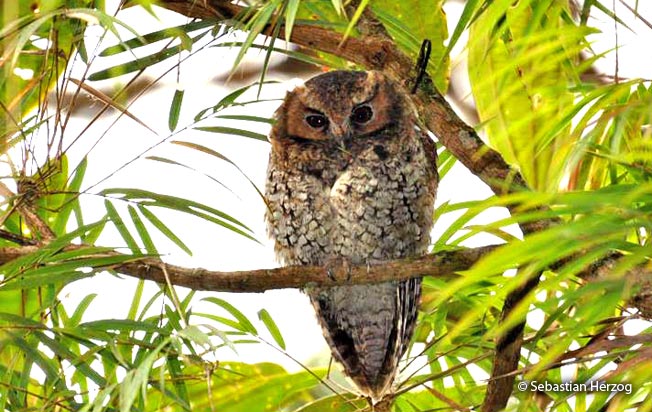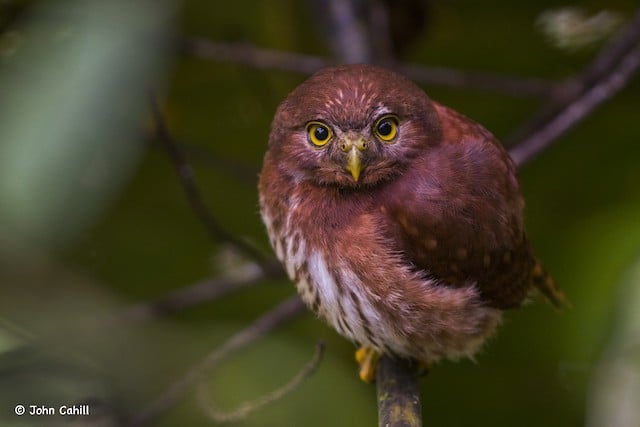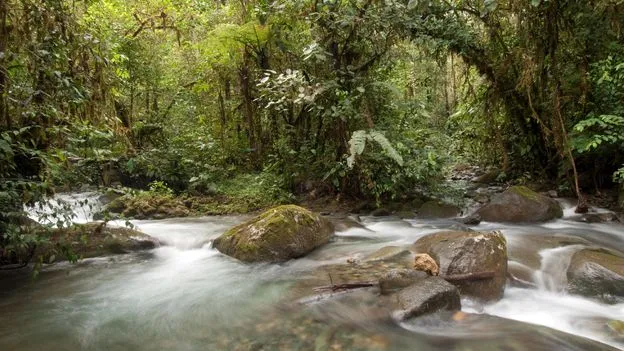For more than 30 years, José DeCoux woke each morning to a deafening noise. In his home in Ecuador’s Los Cedros forest, monkeys squeal, squirrels scuffle, and 400 species of bird flit and squawk. A mist hangs in the trees, and ferns and mosses in countless shades of green cover every rock and tree trunk.
DeCoux moved to the Los Cedros reserve in northern Ecuador from the US in the 1980s. He was “sort of heeding the call to save the rainforest, or something”, he told BBC Future Planet with a smile in April.
With the help of friends and non-profits including Friends of the Earth Sweden and the Rainforest Information Center of Australia, DeCoux bought land in Los Cedros forest, and a conservation and eco-tourism project was born. DeCoux managed the reserve until his death in May, four years after being diagnosed with cancer.
Despite extensive deforestation in the surrounding region, Los Cedros’ 11,681 acres (4,800 ha) buzz and thrum with life. Its biodiversity is astonishing: more than 130 scientific papers have been published on the vast number of species that call Los Cedros home – from fungi and orchids to snails, jaguars and bears. Most of the reserve is a cloud forest where the air is heavy with moisture from drenching rain and permanent condensation, which fosters blankets of lichen and strange orchids. Many species can’t be found anywhere else, such as the tiny orange Los Cedros rainfrog.
Life continues to thrive in Los Cedros, but its survival wasn’t always certain – and it is largely thanks to a powerful, and increasingly influential, global legal movement that the forest is still standing.
In 2008, Ecuador became the first country to change its constitution to state that nature has the same rights as people. The change was led by Ecuador’s Indigenous movement, and marked one of the first major steps in what has become known as the ‘rights of nature’ movement – a movement centred on a legal framework that recognises the inherent right of the natural world to the same protections as people and corporations.
The rights of nature movement “is a move to transform natural entities from objects to subjects, in courts and in front of the law”, says Jacqueline Gallant from New York University’s School of Law’s Earth Rights Advocacy Clinic. “But in a much broader sense, it’s been a movement to reanimate and recentre nature as a subject of intrinsic worth,” Gallant explains. This is in contrast, she says, to the Western view of nature as “an inanimate backdrop against which the drama of human activity unfolds”.
“The rights of nature movement reanimates and recentres nature as a subject of intrinsic worth” – Jacqueline Gallant
To date, initiatives to recognise the rights of nature have been pursued in 44 countries, from Bolivia to Brazil and Uganda to the US. Some cases have defended a single animal, while other legal decisions have recognised the rights of rivers, mountains, and all of Mother Earth. Still, legal practice in this area is relatively new, with few clear precedents for what nature rights look like in action.
DeCoux initially took his case to court in 2019, when a mining company began explorations in the area. DeCoux argued that allowing mining in the forest would violate the rights of nature, and defended Los Cedros forest’s right to exist, survive and regenerate. The case was thrown out of the lower courts – the judge “just didn’t like it”, DeCoux said – but was later selected by the Constitutional Court as a case that would provide a real world of example of the rights of nature. Finally, in 2021, DeCoux won. The judge ruled that mining would harm the biodiversity of the forest, and therefore violate the constitutional rights of nature. “The litigation was successful beyond our wildest dreams,” DeCoux said.
The case was an opportunity for judges to look at the rights of nature beyond the theoretical framework of Ecuador’s Constitution. It would help determine what these rights look like in action, and set a precedent for future cases, DeCoux believed.
Gallant explains this distinction. The US Constitution includes the right to free speech, for example, and centuries of case law now explain how this right plays out in the real world, she says. “Constitutions lay out the law in a level of generality that doesn’t always provide a roadmap about how it plays out in practice,” she says. “So that’s why the ruling on Los Cedros is really important, because it helps explain what the rights of nature provisions in the Constitution actually mean in practice.”
The ruling on Los Cedros was all the more powerful for specifying that it did not only apply to protected areas, but – as with any constitutional right – to the entire territory of the country. The judges were also clear that the area deserves protection in its own right, not just because it provides resources, like clean water, to humans.
Their verdict has turned the rights of nature from a constitutional idea into a practical reality. As Gallant says, “there are people around the world looking at it and seeing how a court has articulated what the rights of nature means in practice, and they say, ‘Great, let’s try and do this in this jurisdiction’. And that’s how the global movement advances”.
In Los Cedros, the verdict was resoundingly good news for the animals, plants and fungi that live there. Mining has not happened, and the forest has therefore not suffered. The mining companies had to remove their machinery immediately, and the court put a blanket ban on all future mining and all other extractive activities in Los Cedros. “The companies packed their bags and left less than 10 days after the decision came down from the Constitutional Court,” DeCoux told the BBC when we spoke to him.
But the outcome of nature rights cases isn’t always so clear, or positive – even when a court rules in nature’s favour. The River Ganga in India, for example, was recognised as a legal person in 2017, but by 2023 pollution has continued to the extent that most of its water remains undrinkable.
“Some courts hand down the rulings and then forget about them, they never go back to them again,” says César Rodríguez-Garavito, professor of clinical law and director of the More-Than-Human Rights (Moth) Project at NYU School of Law – an initiative that brings together law, science and the arts to advance rights for humans, non-humans and the broader web of life.
To quantify the impact of the court’s decision on Los Cedros, Rodríguez-Garavito has spent time in the area, speaking to scientists and other key actors, and observing the outcomes two years on from the ruling. He has looked at the precise ways in which the ruling has been acted on, and the practical impact of that on the forest. His research concludes that Los Cedros has remained a sanctuary for biodiversity – and that this would very likely not have been possible without the ruling. “Definitely, both in and of itself, and compared to other rights of nature rulings, the picture is positive,” he says.
However, Rodríguez-Garavito’s findings also highlight that the forest remains vulnerable. The Ecuadorian government has passed the burden of protection to other state and private actors, who have limited resources to monitor and protect the land. And mining permitted in nearby areas could have “spillover effects” on Los Cedros, and boost illegal hunting, logging and mining on the reserve’s borders.
In his interview with the BBC, De Coux was adamant there was still work to do. “The game is not over yet,” he said. "The forces of the extractive industries are still actively working against us.
“But I’m certainly very happy with the position we’re in today because we’ve got a way forward.”
Rodríguez-Garavito says that his research provides a template for tracking and measuring the impact of future legal decisions on the rights of nature. “We wanted to propose a methodology for future similar reports,” he says. “We’re trying to create some accountability.”
The work of the rights of nature movement is powerful, but it cannot operate alone – and nor should it, Gallant says. Moth’s work is interdisciplinary, bringing together science, culture and the arts – because, she says, “the judiciary alone can’t do everything that’s needed to promote a paradigm where the more than human world is valued more centrally and where we structure our politics and our culture to reflect that more”.
Gallant points out that, importantly, the rights of nature movement is a vehicle for Indigenous principles and priorities to have sway, and that these ideas are leading the rest of the world.
“These [philosophical ideas] are not new inventions, they are things that Indigenous peoples around the world have been saying for time immemorial,” Gallant says. “Movements and organisations in the Global South have been on the frontlines of advancing these concepts politically, legally, socially. It’s a really good example of the Global North learning something really important from the Global South.”
Give personhood rights to nature
Not corporations.
She was here first, just sayin’…
Cloud Forest Gang checking in!
Cloud Forest Screech Owl:

Cloud Forest Pygmy Owl:





